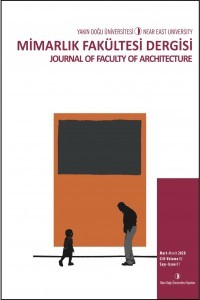Görsel Kültürün Şekillendirdiği Geleceğin Şehirleri
20. yüzyılın başında modernizm tüm uygulamalı sanat alanlarında etkisini göstermiştir. Fütürizm, bu yeniçağı manifestosu ile karşılamıştır. Modern dönem, gelenekçiliğin tüm eski bağlarını yıkması ve yönünü sanayi devriminin gelişmelerine çevirmesi gerektiğinin altını çizmiştir. Mimarlık geleneği inceleyerek ve onu endüstriyel devrimle birleştirerek kendi dilinin söz varlığını oluşturarak kendi dinamiklerini oluşturmuştur. Öncü mimar Le Corbusier, eskizlerinde özellikli şehirlerin görünümünü resmederken, bazı yeni sanat formlarının da önünü açmıştır. Bu sırada; yeni sanat formu olarak sinema, yenidünyanın mimarları olarak geleceğin şehirlerini görselleştirmiş ve sanal bir potansiyel ve öngörü ortaya koyarak şehirlerin gelecekteki olası görünümünü gözler önüne sermiştir. Bu araştırmanın amacı, günümüz kentlerinde gerçeğe dönüşen film temelli bilimkurgu varsayımlarını inceleyerek, 1980'li yılların sinema endüstrisinin geleceğin şehirleri üzerindeki etkilerini ve üç boyutlu grafiklerin geleceğin şehirlerinin mimari cephelerine yansımalarını araştırmaktır.
Anahtar Kelimeler:
Mimarlık, 3D Grafikler, Cephe, Gelecekçilik, Bilim- Kurgu, Sinema
The Future Cities that were shaped by Visual Culture
At the turn of the 20th century modernism was it’s own way. Futurism has its manifesto by expressing of the celebration of the new era. It was underlining the fact that new era should destroy all previous ties of traditionalism and one should turn its head to the developments of industrial revolution. Architecture created its own dynamics by examining the tradition, later combining it with revolution and at the end creating the vocabulary of its own language. As Pioneer architect Le Corbusier illustrated the appearance of feature cities in his sketches some other new art forms were on its way. Meanwhile; cinema as the new art form, visualised and rather prophecisied future cities as architects of the new world foreseen the facts of the future appearance of the cities. The aim of this paper is to investigate the effects of the cinema industry of 1980’s on future cities and the reflections of three dimensional graphics on architectural facades of the future cities by examining the movie based sci-fi hallucinations that come to be true in today’s cities
Keywords:
Key words: Architecture, 3D graphics, Façades, Futurism, Sci- Fi, Cinema,
___
- Abouhela, I. M., Dewidar, K. M., & El-Gohary, A. F. (2007). The Image of Future City in Science Fiction Films. Retrievd from https://www. researchgate. net/publication/305999595_The_Image_of_Future_City_in_Science_Fiction_Films.
- DE LA IGLESIA, Martin. Has Akira Always Been a Cyberpunk Comic?. In : Arts. MDPI, 2018. p. 32.
- EINSTEIN, Albert. Imagination is more important than knowledge. Knowledge is limited. Imagination encircles the world. International Journal of High Speed Electronics and Systems, 2000, vol. 10, no 2, p. 413.
- GORMAN, Clare. The undecidable: Jacques Derrida and Paul Howard. Cambridge Scholars Publishing, 2015.
- https://gadgettendency.com/3d-effect-panel-on-shopping-mall-facade-in-china-video/
- MCLEOD, Saul. Jean Piaget's theory of cognitive development. 2007.
- Pascal Michon, Gilles Deleuze & Felix Guattari and the Rhuthmoi of War – Part 3 , Rhuthmos, 2021
- Roth, L. M. (2018). Understanding architecture: Its elements, history, and meaning. Routledge
- WEISDORF, Jacob L. From foraging to farming: explaining the Neolithic Revolution. Journal of Economic surveys, 2005, vol. 19, no 4, p. 561-586.
- ISSN: 2687-2757
- Başlangıç: 2019
- Yayıncı: Yakın Doğu Üniversitesi
Sayıdaki Diğer Makaleler
Learning from tradition for future: Green building in Kano state, Nigeria
Mukhtar SABIU YAHUZA, Huriye GÜRDALLI
The Impact of Tall Buildings within the Existing and Historical Urban Environment
İsmaeel GHAZALEHENİYA, Ayten ÖZSAVAŞ AKÇAY
Görsel Kültürün Şekillendirdiği Geleceğin Şehirleri
Serkad Hasan IŞIKÖREN, Derin ŞİRVAN IŞIKÖREN
Shaymaa Jalil IBRAHIM, Çilen ERÇİN, Carol Kamil Toma KHARBOSH
